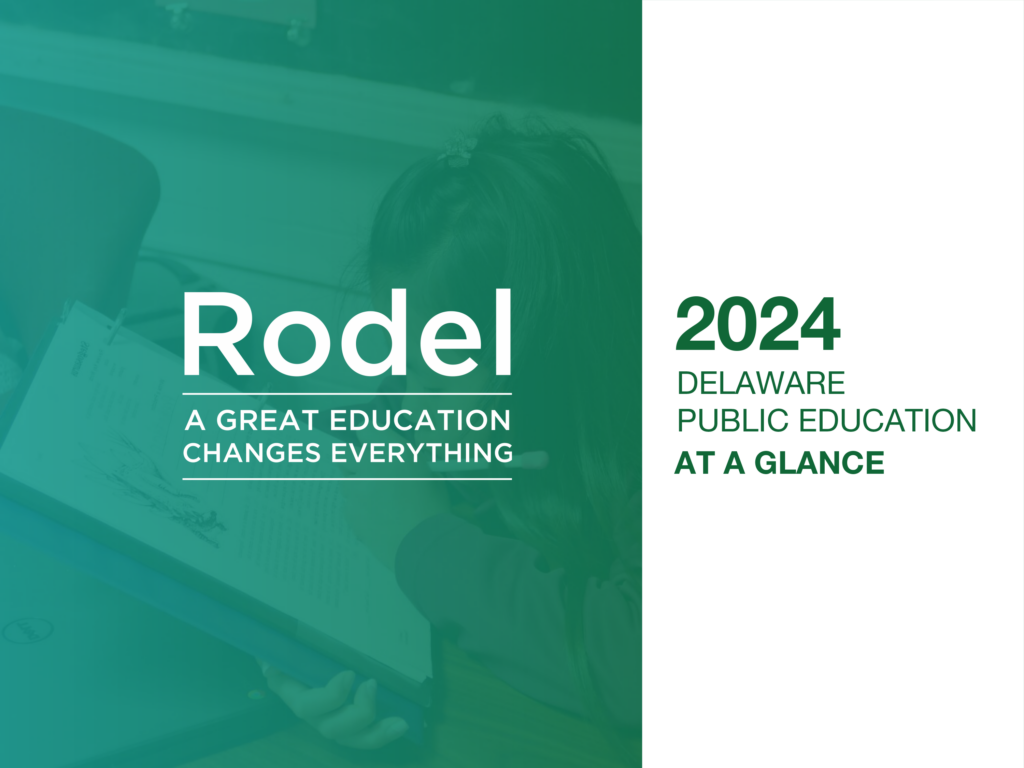Delaware Education At A Glance: 10 Things to Know
Delaware Education at a Glance: 10 Things to Know
Education in Delaware is constantly evolving and changing. Rodel’s goal is to keep citizens, educators, and politicians informed on the latest developments in local education. So, we’ve pulled 10 facts from Rodel’s 2024 Delaware Public Education At A Glance report to show the current state of Delaware education; from enrollment and high school pathway implications to early learning and career preparation. Take a look at Rodel’s full 2024 At A Glance report for more.
- 81 percent of educators in Delaware are white or Caucasian.
- Men of color account for only 4.3 percent of instructors in Delaware. Delaware is trying to increase educator diversity and retention, specifically when it comes to teachers of color.

- Students of color comprise more than half of Delaware students.
- Delaware’s student body is made up of approximately 61 percent students of color. Increasing the number of teachers of color in Delaware will help to give more students role-models and educators who may better understand the unique experiences of students of color.
- Most multilingual learner (MLL) students in Delaware are native-born. MLL students speak 90 different languages.
- Despite being the fastest-growing student population in Delaware, MLLs continue to face a lack of resources, often depending on the availability of teachers.
- In 2018 Delawareans for Education Operation and NAACP filed a lawsuit against Delaware and Governor John Carney, claiming the state utilizes an inequitable school funding system.
- The lawsuit, which was in response to Delaware’s “unit-based” funding system, claimed that educational resources were not fairly distributed. Delaware is one of the few states to utilize this outdated system, which divides monetary resources based on enrollment, without dedicated resources for low-income students and multilingual learners (MLLs). The lawsuit was eventually settled out of court, but the question of whether Delaware’s spending on education is adequately divided remains an open discussion.

- Delaware is ranked 15th nationally in spending per student, with an average of $20,231 invested per learner in 2023.
- While $20,231 may seem generous, the educational needs of students can vary depending on a variety of factors. To combat concerns that this funding is not being distributed equitably to account for these factors, Delaware has implemented Opportunity Funding, which provides between $800 and $900 per student from a low-income background. American Institutes for Research (AIR) suggested that 100-200 percent more funding allocated to the needs of high-needs students.

- The annual cost for child care in Delaware exceeds the median household income.
- A family of four would need to earn $88,683 annually to afford child care. The median income for a family of four in Delaware is only $86,683.
- Only 16 percent of Delawarean children have access to publicly funded early education services.
- This means that close to 85 percent of children do not have access to publicly funded care, and have to look to either privately funded options, which can end up being just as expensive as college or household-centered care. Lack of access to child care can also make it harder for parents to rejoin the workforce.

- Investments in Early Childhood Education (ECE) result in an estimated six-10 percent return per year for every dollar spent.
- More than one million new neuronal connections are formed every second in the first few years of childhood, making this an incredibly rich time for learning when compared to later years. However, Delaware invests only a fraction of what they spend on K-12 into ECE.


- Contrary to common perception, Delaware public school enrollment is up.
- A common perception in Delaware is that public school enrollment is down, and most students attend private schools. On the contrary, only about one in 10 students in the state go to private schools.
- Delaware pathways provided over 900 accelerated opportunities for students.
- The pathways programs help students find their career path and take the next steps to build their experience and qualifications for later success in their respective industries. Many high-demand industries pathways (such as healthcare, computer science, engineering, and manufacturing) have seen enrollment growth.
Related Topics: Delaware education, delaware pathways, delaware schools, early learning, education data, school funding
